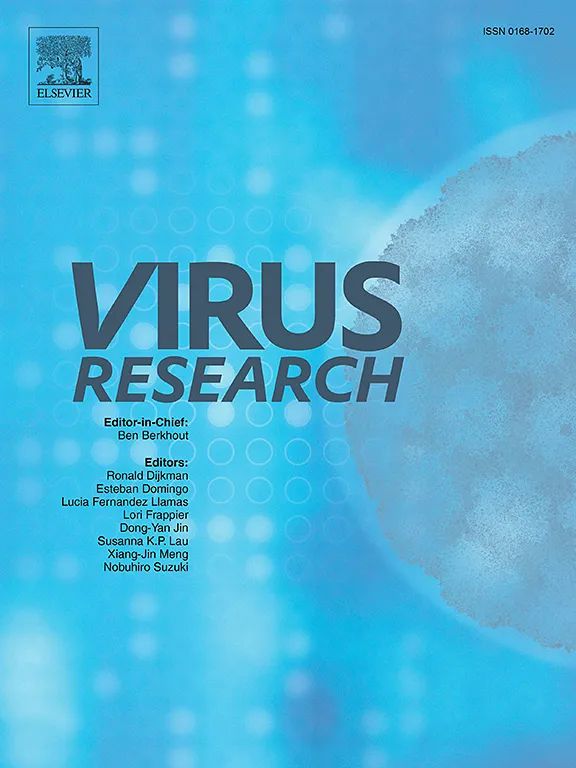Screening and identification of linear B-cell epitopes on structural proteins of African Swine Fever Virus
IF 2.5
4区 医学
Q3 VIROLOGY
引用次数: 0
Abstract
This study aims to screen and identify linear B-cell epitopes on the structural proteins of African Swine Fever Virus (ASFV) to assist in the development of peptide-based vaccines. In experiments, 66 peptides of 12 structural proteins of ASFV were predicted as potential linear B-cell epitopes using bioinformatics tools and were designed; the potential epitope proteins carried the GST tag were expressed, purified, and subjected to antigenicity analysis with porcine antiserum against ASFV, and further identified based on their immunogenicity in mice. A total of 22 potential linear B-cell epitopes showed immunoreactivity and immunogenicity. Of these epitopes, 13 epitopes were firstly identified including 4 epitopes located in p72 (352–363, 416–434, 424–439, 496–530 aa), 3 epitopes located in pE248R (121–136, 138–169, 158–185 aa), and only one epitope of each protein of pH108R (33–46 aa), p17 (63–86 aa), pE120R (65–117 aa), pE199L (175–189 aa), p12 (36–56 aa) as well as pB438L (211–230 aa). Notably, the immunoreactivity of the epitopes from the 63-86 aa of p17 and the 65–117 aa of pE120R were the highest amongst identified epitopes, while the immunogenicity of epitopes from the 36–56 aa of p12, the 211–230 aa of pB438L, the 352–363 aa of p72 and the 63–86 aa of p17 were the best strong. The other 9 epitopes are partly overlapped with previous researches. These epitopes identified here will further enrich the database of ASFV epitope, as well as help to develop safe, effective epitope-based ASF vaccines and ASF diagnostic reagents.
筛选和鉴定非洲猪瘟病毒结构蛋白上的线性 B 细胞表位。
本研究旨在筛选和鉴定非洲猪瘟病毒(ASFV)结构蛋白上的线性B细胞表位,以帮助开发基于多肽的疫苗。在实验中,利用生物信息学工具预测了非洲猪瘟病毒 12 种结构蛋白中的 66 个肽段,并设计了潜在的线性 B 细胞表位;对这些潜在表位蛋白进行了 GST 标记表达、纯化,并用猪抗血清对非洲猪瘟病毒进行了抗原性分析,根据其在小鼠中的免疫原性进一步鉴定。共有 22 个潜在的线性 B 细胞表位显示出免疫反应性和免疫原性。在这些表位中,首先确定了 13 个表位,包括位于 p72 的 4 个表位(352-363、416-434、424-439、496-530 aa)、位于 pE248R 的 3 个表位(121-136、138-169、158-185 aa),pH108R(33-46 aa)、p17(63-86 aa)、pE120R(65-117 aa)、pE199L(175-189 aa)、p12(36-56 aa)和 pB438L(211-230 aa)的每个蛋白质只有一个表位。值得注意的是,在已鉴定的表位中,p17 的 63-86 aa 表位和 pE120R 的 65-117 aa 表位的免疫活性最高,而 p12 的 36-56 aa 表位、pB438L 的 211-230 aa 表位、p72 的 352-363 aa 表位和 p17 的 63-86 aa 表位的免疫原性最强。其他 9 个表位与之前的研究有部分重叠。这些表位的发现将进一步丰富 ASFV 表位数据库,并有助于开发安全、有效的基于表位的 ASF 疫苗和 ASF 诊断试剂。
本文章由计算机程序翻译,如有差异,请以英文原文为准。
求助全文
约1分钟内获得全文
求助全文
来源期刊

Virus research
医学-病毒学
CiteScore
9.50
自引率
2.00%
发文量
239
审稿时长
43 days
期刊介绍:
Virus Research provides a means of fast publication for original papers on fundamental research in virology. Contributions on new developments concerning virus structure, replication, pathogenesis and evolution are encouraged. These include reports describing virus morphology, the function and antigenic analysis of virus structural components, virus genome structure and expression, analysis on virus replication processes, virus evolution in connection with antiviral interventions, effects of viruses on their host cells, particularly on the immune system, and the pathogenesis of virus infections, including oncogene activation and transduction.
 求助内容:
求助内容: 应助结果提醒方式:
应助结果提醒方式:


